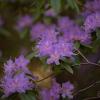February 11, 2004 - 4:00pm
At least for sockeye salmon.
<?xml:namespace prefix = o ns = "urn:schemas-microsoft-com:office:office" />
Sea-going sockeye salmon and their lake-resident form, kokanee, turn bright red at sexual maturity. Now a team of Canadian researchers, led by Dr. Chris Foote, a Professor in the Department of Fisheries and Aquaculture at Malaspina University-College, have shown that the bright red colour is all about attracting mates.
“That alone is not surprising - red is a sexual signal in many animals,” said Dr. Foote. “What is surprising is that the red colour in sockeye salmon and kokanee is produced through different evolutionary pathways.”
In a paper published this week in the international scientific journal Animal Behaviour, Dr. Foote explains that the development of this red breeding colour “is the only known example of sexual selection driving a single species towards formation of a new species through love of the same thing.”
“Their love of red has driven them genetically apart,” said Dr. Foote, who’s spent over 20 years studying the role of sexual behaviour in the divergence of sockeye salmon and kokanee.
Typically, mate choice is thought to drive species or populations apart through preference for different characters. In this case, both forms of the species – sockeye and kokanee - love the colour red, and the love of red drives them to turn red at breeding.
“They’ve developed mechanisms for transferring red carotenoid pigments from the flesh to the skin at sexual maturity,” explained Dr. Foote.
The red pigment comes from their diet, which they store in their flesh giving it the typical “orange-red salmon” colour. When they mature, they mobilize the pigment from their flesh and deposit it in their skin, causing it to turn bright red. Females deposit a large proportion of their pigment in their eggs, and as a result, don’t turn as red.
But the special pigment is relatively scarce in freshwater environments, so kokanee as they split off from sockeye over the last 10,000 years, couldn’t originally gather enough carotenoids in their diet to turn red at maturity. They turned a distinctly non-amorous green instead.
“Even so, kokanee inherited a preference for red mates from sockeye,” said Dr. Foote. “This strong selective pressure drove kokanee to develop more efficient ways to utilize the scarce carotenoids in their food, so that they turn red today.”
Dr. Foote and Dr. Kevin Craig at Duke University in the United States previously discovered that kokanee salmon are three times more efficient in utilizing carotenoids than seagoing sockeye. Now they know why.
“So, sexual selection – the strong drive for red mates – has resulted in two forms that appear identical in colour, but are in fact genetically distinct,” he said. “The fact that sockeye and kokanee look the same hides the fact that they are genetically different.”
The research is significant because it’s a look at a unique process of how species come to exist.
“The research happens to be conducted in B.C. and Alaska but the story is bigger than that,” said Dr. Foote. “We’re always speculating as to how different species come to exist, but there are few cases where you can watch the process in action. Even then, we tend to look for physical differences across emerging species when trying to understand the evolutionary processes at play.
“This research points out that we should look to the evolutionary forces that make animals look the same as well as what makes them look different. If two things look the same, they may indeed be different. What you see, is not necessarily what you get.”
Dr. Foote’s research team includes Dr. Gayle Brown, a research biologist at the Pacific Biological Station for the Canadian Department of Fisheries and Oceans, and Dr. Craig Hawryshyn, a Professor in the Department of Biology, University of Victoria.
For more information, contact Dr. Chris Foote at footec@viu.ca or (250) 753-3245 ext. 2406, or check his website at: www.viu.ca/fisheries/foote.htm.
For film footage of male sockeye salmon demonstrating their attraction to red abstract female models visit the link: www.viu.ca/fisheries/movies/sockeye.htm.
Tags: In the Community






